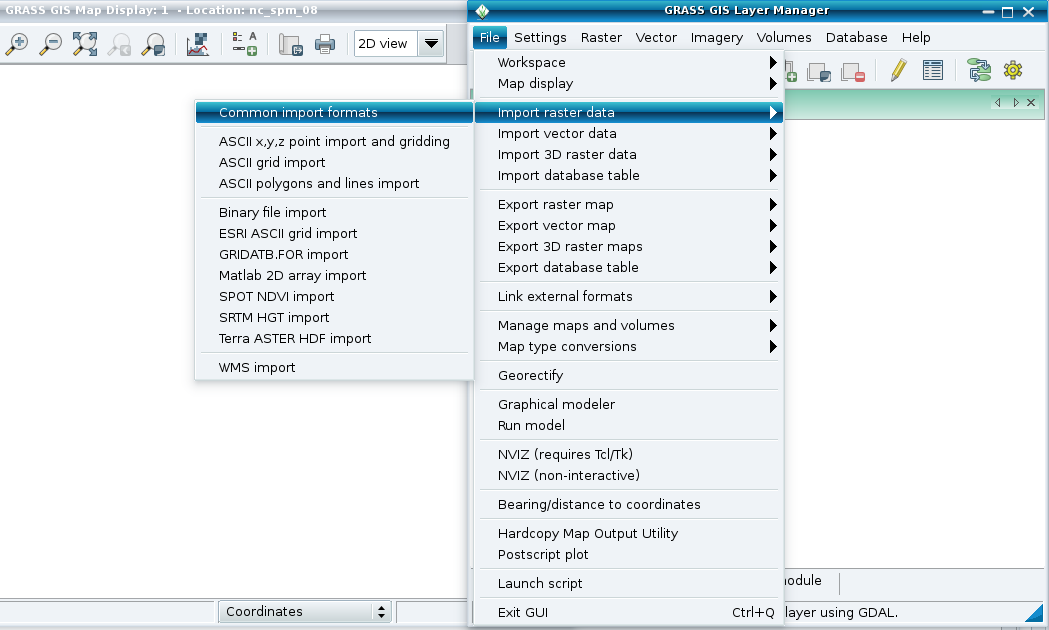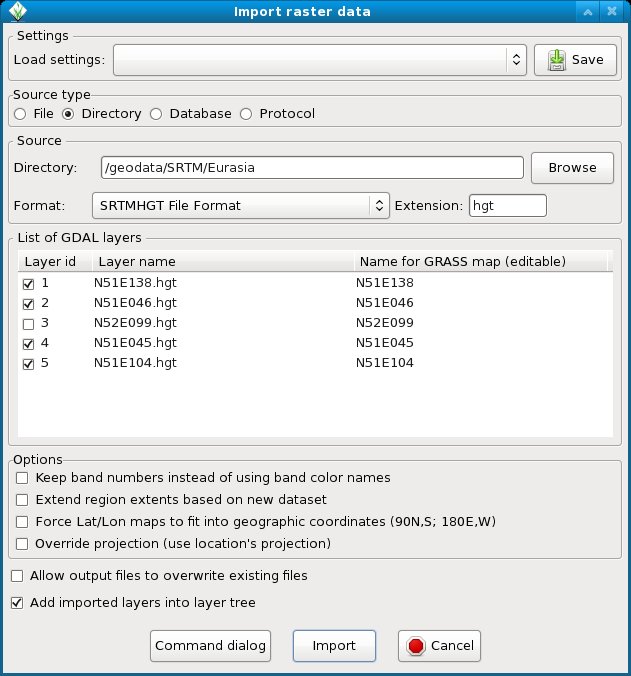HOWTO import SRTM elevation data: Difference between revisions
(mention SRTM 1 Arc-Second Global elevation data) |
|||
| Line 55: | Line 55: | ||
* SRTM 90 data in GeoTIFF format are available from http://srtm.csi.cgiar.org/. These come in 5 degree by 5 degree tiles. Horizontal resolution: 3 arc second (90 m at equator). Coverage: world. Import with {{cmd|r.in.gdal}} | * SRTM 90 data in GeoTIFF format are available from http://srtm.csi.cgiar.org/. These come in 5 degree by 5 degree tiles. Horizontal resolution: 3 arc second (90 m at equator). Coverage: world. Import with {{cmd|r.in.gdal}} | ||
Update: note that NASA EarthExplorer (see on top of this page) offers ~ 30m resolution SRTM V3 data which are void filled. | |||
== Import of multiple SRTM tiles in one step (mosaiking) == | == Import of multiple SRTM tiles in one step (mosaiking) == | ||
Revision as of 07:58, 16 May 2016
Background: Space Shuttle Radar Topography Mission
Available data
Space Shuttle Radar Topography Mission - several SRTM Data Products are available:
- Original data - SRTM 3 arc-seconds Non-Void Filled elevation data V1 (US: 1 arc-second (approximately 30 meters); outside the US at 3 arc-seconds (approximately 90 meters))
- SRTM Void Filled elevation data V2, filled the voids using interpolation algorithms in conjunction with other sources of elevation data (US: 1 arc-second (approximately 30 meters); outside the US at 3 arc-seconds (approximately 90 meters))
- SRTM 1 Arc-Second Global elevation data V3 offer worldwide coverage of void filled data at a resolution of 1 arc-second (30 meters) and provide open distribution of this high-resolution global data set.
- EarthExplorer can be used to search, preview, and download Shuttle Radar Topography Mission (SRTM) 1 Arc-Second Global data. The collections are located under the Digital Elevation category.
Download
- Older SRTM: http://www2.jpl.nasa.gov/srtm/ (SRTM V1 + SRTM V2 home page) | http://dds.cr.usgs.gov/srtm/ (SRTM V2 data download)
- https://lpdaac.usgs.gov/dataset_discovery/measures/measures_products_table NASA MEaSUREs Products (SRTM V3 and more)
- (FTP - therein SRTMGL3.003/2000.02.11/ which is a huge file list)
- Map based search: EarthExplorer can be used to search, preview, and download Shuttle Radar Topography Mission (SRTM) 1 Arc-Second Global data. The collections are located under the Digital Elevation category.
Note: GRASS GIS installations usually contain a location 'demolocation' which is in Latitude-Longitude, suitable for SRTM import.
Which SRTM tile to take?
SRTM tiles are of 1 degree by 1 degree size. The SRTM filename contains the coordinates which refer to the center of the lower left pixel (e.g., N51E010: lower left cell center at 10E, 51N). To identify a tile name, a grid can be easily visualized in the GRASS monitor:
d.grid size=1
Import of original SRTM tiles in HGT format
You can easily import many SRTM files in one step:
 |
 |
This menu function calls internally the SRTM driver of GDAL.
Importing multiple SRTM files via command line
Use the r.in.srtm module for automated import into a Latitude-Longitude location.
See:
- M.H. Bowman. Mapping freely available high resolution global elevation and vector data in GRASS. GRASS Newsletter, Vol.3, pp 7-10, June 2005. [ PDF ]
Import of CGIAR SRTM void-filled tiles
- SRTM 90 data in GeoTIFF format are available from http://srtm.csi.cgiar.org/. These come in 5 degree by 5 degree tiles. Horizontal resolution: 3 arc second (90 m at equator). Coverage: world. Import with r.in.gdal
Update: note that NASA EarthExplorer (see on top of this page) offers ~ 30m resolution SRTM V3 data which are void filled.
Import of multiple SRTM tiles in one step (mosaiking)
To simplify the import of multiple SRTM tiles, the tiles can be mosaicked first with gdalwarp:
Original SRTM tiles:
# unzip all
for i in *.hgt.zip ; do unzip $i ; done
# create mosaik (optionally reproject on the fly with -t_srs)
gdalwarp *.hgt srtm_mosaik.tif
# import
r.in.gdal input=srtm_mosaik output=srtm_mosaik
CGIAR SRTM tiles:
# create mosaik (optionally reproject on the fly with -t_srs)
gdalwarp *.tif srtm_mosaik.tif
# import
r.in.gdal input=srtm_mosaik output=srtm_mosaik
Void filling of original SRTM tiles
The module r.fillnulls can be used. See screenshot
See:
- M. Neteler, 2005. SRTM and VMAP0 data in OGR and GRASS. GRASS Newsletter, Vol.3, pp 2-6, June 2005. [ PDF | Erratum 1/2006 (txt) ]
See also
- SRTM in Wikipedia